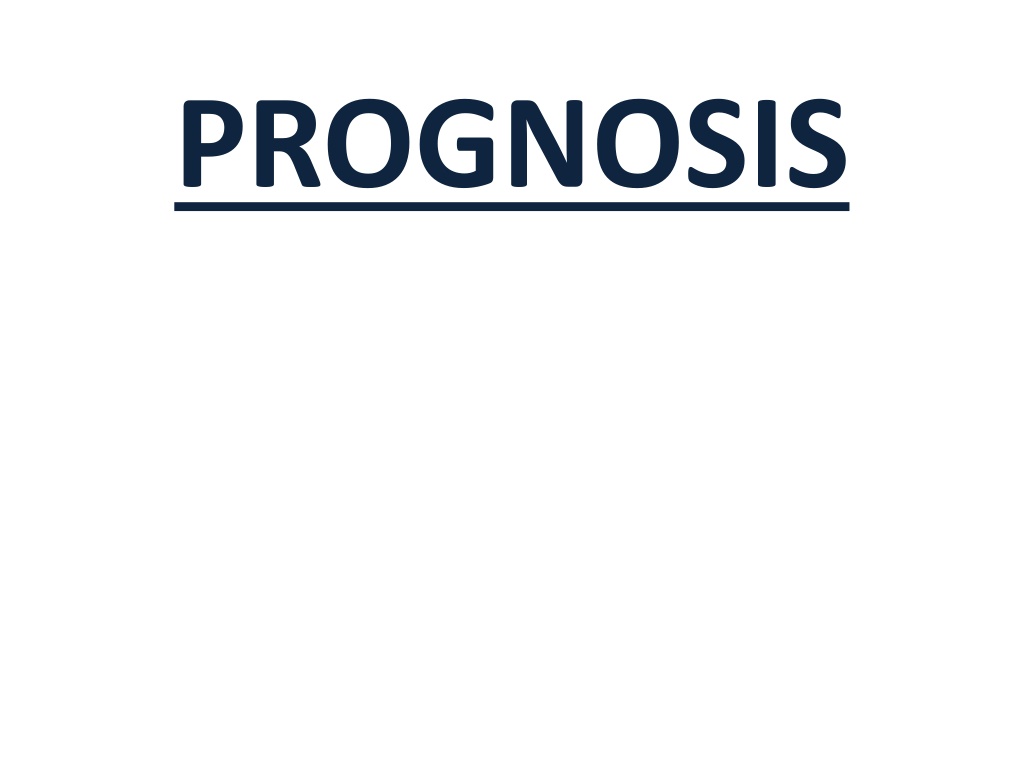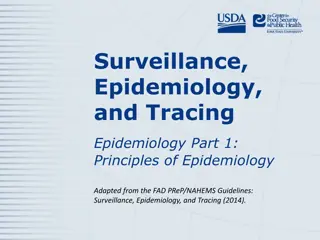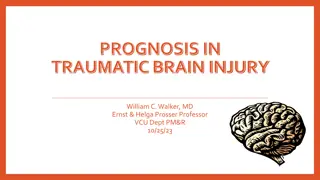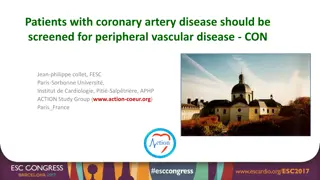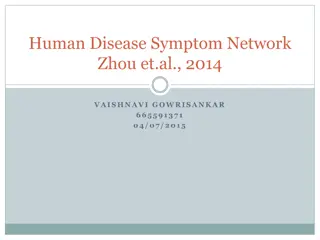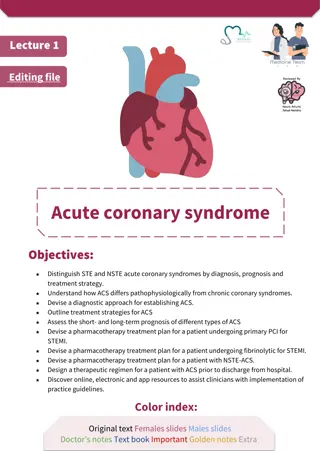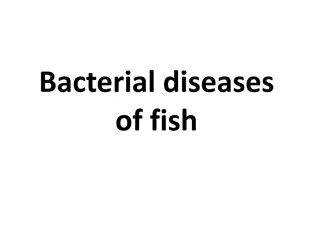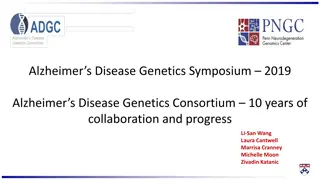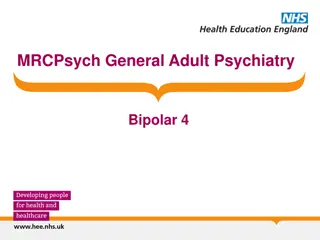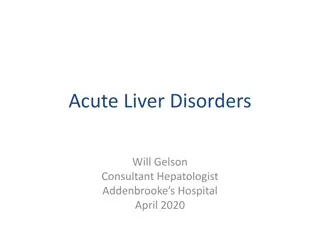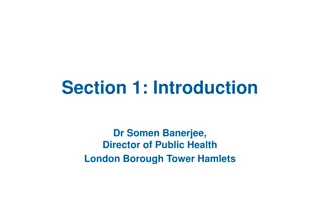Prognosis in Disease Management
Prognosis involves predicting the course, duration, and outcome of a disease, along with treatment response likelihood. Explore types of prognosis from excellent to hopeless, factors determining prognosis, and classification considerations like overall and individual tooth prognosis in dental care.
Download Presentation

Please find below an Image/Link to download the presentation.
The content on the website is provided AS IS for your information and personal use only. It may not be sold, licensed, or shared on other websites without obtaining consent from the author.If you encounter any issues during the download, it is possible that the publisher has removed the file from their server.
You are allowed to download the files provided on this website for personal or commercial use, subject to the condition that they are used lawfully. All files are the property of their respective owners.
The content on the website is provided AS IS for your information and personal use only. It may not be sold, licensed, or shared on other websites without obtaining consent from the author.
E N D
Presentation Transcript
Learning objectives- 1.Definition 2.Types 3.Classification 4.Factors determining
DEFINITION Prognosis is the prediction of the probable course , duration , and outcome of a disease and the likelihood of its response to treatment, based on general knowledge of the pathogenesis of the disease and the presence of risk factors .
Types of prognosis:- 1.Excellent prognosis 2.Good prognosis 3.Fair prognosis 4.Poor prognosis 5.Questionable prognosis 6.Hopeless prognosis
1.Excellent prognosis:- No bone loss Excellent gingival condition Good patient cooperation No systemic or environmental factors 2.Good prognosis:- - Adequate remaining bone support Adequate possibilities to control etiological factors Adequate patient cooperation No systemic or environmental factors or if present they are well controlled
3.Fair prognosis:- Less than adequate remaining bone support Some tooth mobility Grade 1 furcation involvement Acceptable patient cooperation Presence of limited systemic or environmental factors 2.Poor prognosis:- Moderate to advanced bone loss Tooth mobility grade 1 and2 furcation involvement Doubtfull patient cooperation Presence of systemic or environmental factors
5.Questionable prognosis:- Advanced bone loss Grade2 and 3 furcation involvements Tooth mobility Presence of systemic or environmental factors 6.Hopeless prognosis:- Advanced bone loss Non maintainable areas Extractions indicated Presence of uncontrolled systemic or environmental factors
For descriptive purposes and better understanding , prognosis is classified as follows 1. overall prognosis:- it is concerned with patient and dentition as a whole and it is determined by several factors including the type of disease , age of the patient , systemic background. 2. individual tooth prognosis:- it is determined after the overall prognosis and is affected by it.
Prognosis is also classified as:- 1.Therapeutic prognosis:- It deals with the response of tissues to treatment and successful arrest of disease process. It is the prognosis of teeth after an appropriate periodontal treatment is provided
2.Prosthetic prognosis:- It indicates the ability of the remaining teeth to support a prosthesis it is the prognosis of the teeth for supporting the prosthetic restoration after an appropriate periodontal treatment has been provided
Factors in determination of overall prognosis:- 1.Type of disease:- A) prognosis for patients with gingival diseases B) prognosis for patients with periodontitis 2.Age of the patient 3.Rate of disease progression 5.Systemic background 6.Genetic factors 7.Smoking 8.Stress 9.Number of remaining teeth and their distribution 10.Patient compliance and cooperation
1.Prognosis of patient with gingival diseases:- A) plaque induced gingival diseases:- - Gingivitis associated with dental plaque only:- plaque induced gingivitis is reversible disease that occurs when bacterial plaque accumulates at gingival margin. so, in this case prognosis is good. -Plaque induced gingival diseases modified by systemic factors:- inflammatory response to bacterial plaque at the gingival margin can be influenced by systemic factors such as endocrine related changes associated with puberty, menstruation , pregnancy and diabetes.
So , the long term prognosis for these patients depends not only on the control of bacterial plaque but also on control of systemic factors. - Plaque- induced gingival diseses modified by medication:- Gingival diseases associated with medications include drug induced gingival enlargement , continuous use of the drugs usually results in recurrence of the enlargement even after the surgical intervention. Long term prognosis is given which depends on whether the patients systemic problem can be treated with medication that does not have this side effect
B) Non plaque induced gingival diseases:- This can be seen in patients with a variety of bacterial ,fungal and viral infections. In this case prognosis depends on elimination of source of infectious agents.
2.Prognosis for patient with periodontitis :- A)chronic periodontitis :- In case of slight to moderate periodontitis , prognosis is generally good provided good oral hygiene and removal of local retentive factors. In patients with severe periodontitis , prognosis may be fair to poor.
B)Aggressive periodontitis:- Aggressive periodontitis can be present in a localized or generalized form. When localized aggressive periodontitis diagnose early, these can be treated by giving oral hygiene instructions and antibiotic therapy ,resulting in excellent prognosis . patients diagnosed with generalized aggressive periodontis, have fair, poor or questionable prognosis.
3.Age of the patient:- For two patients with comparable levels of remaining connective tissue attachment and alveolar bone, prognosis is generally better for the older of the two. 4. Rate of disease progression:- A rapid loss of bone in a short time is indicative of factors beyond local irritants and often difficult to control. Prognosis is poor in such cases.
5.Systemic background:- It follow that prognosis in these cases depends on patients compliance relative to both medication and dental status . Well controlled diabetes patients with slide to moderate periodontitis have good prognosis. 6.Genetic factors:- Detection of genetic variations linked to periodontal disease can influence the prognosis in several ways:-
1.Early detection of patients at risk because of genetic factors can lead to early implementation preventive and treatment measures for these patients. 2. Identification of genetic risk factors later in the disease or during the course of treatment can influence the treatment recommendations. 3.Identification of young individuals who have not been evaluated for periodontitis but who are recognized as being at risk because of the familial aggrigation seen in aggressive periodontitis. In each of these cases early diagnosis and alterations in the treatment regimen may lead to an improved prognosis for the patient.
9.Number of remaining teeth and their distribution:- More the No.of teeth remaining better is the overall prognosis. 10.patient compliance and cooperation:- Prognosis for patients with gingival and periodontal disease depends on patients attitude, desire to retain the natural teeth n willingness and ability to maintain good oral hygiene. If the patients are unwilling then dentist can, - Refuse to accept the patient for treatment ,or extract teeth that have hopeless or poor prognosis
7.smoking:- Prognosis in patient who smoke and have slight to moderate periodontitis is generally fair to poor. In patients with severe periodontitis prognosis may be poor to hopeless. 8.stress:- Physical and emotional stress may alter the patients ability to respond to the periodontal treatment performed, these factors must be faced when attemping to establish prognosis.
Factors in determining individual tooth prognosis:- 1.Tooth mobility 2.Anatomical factors 3.Prosthetic and restorative factors
1.Tooth mobility:- The principle causes of tooth mobility are loss of alveolar bone inflammatory changes in PDL and trauma from occlusion. Tooth mobility caused by inflammation and trauma from occlusion may be corrected. Stabilization of tooth mobility through the use of splinting may have a beneficial impact on overall and individual tooth prognosis.
2.Anatomical factors:- Anatomical factors that affect the prognosis includes: Short , tapered roots with large crowns. Cervical enamel projections enamel pearls Bifurcation ridges Root concavities and developmental grooves Furcation invovement .
1.Short tapered roots and relatively large crowns will have poor prognosis. 2. Presence of enamel projection on the root surface may have negative effect on prognosis. 3.Presence developmental grooves root proximity and furcation involvement can worsen prognosis. 4.Anatomical factors that decrease the efficiency of scaling and root planing can have the negative impact on prognosis.
3. Prosthetic and restorative factors:- For teeth with extensive caries feasibility of adequate restoration and endodontic therapy should be considered before undertaking periodontal treatment. More rigid standards are required when evaluating the prognosis of teeth adjacent to edentulous area. A tooth with discrepancy in its sub gingival margin have a poorer prognosis than a tooth with well contoured supra gingival margin
